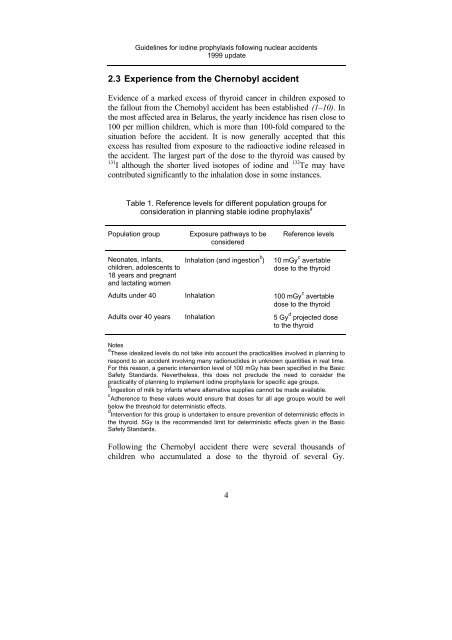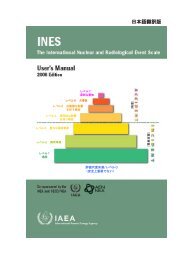Guidelines for Iodine Prophylaxis following Nuclear Accidents
Iodine_Prophylaxis_guide
Iodine_Prophylaxis_guide
Create successful ePaper yourself
Turn your PDF publications into a flip-book with our unique Google optimized e-Paper software.
<strong>Guidelines</strong> <strong>for</strong> iodine prophylaxis <strong>following</strong> nuclear accidents1999 update2.3 Experience from the Chernobyl accidentEvidence of a marked excess of thyroid cancer in children exposed tothe fallout from the Chernobyl accident has been established (1–10). Inthe most affected area in Belarus, the yearly incidence has risen close to100 per million children, which is more than 100-fold compared to thesituation be<strong>for</strong>e the accident. It is now generally accepted that thisexcess has resulted from exposure to the radioactive iodine released inthe accident. The largest part of the dose to the thyroid was caused by131 I although the shorter lived isotopes of iodine and 132 Te may havecontributed significantly to the inhalation dose in some instances.Table 1. Reference levels <strong>for</strong> different population groups <strong>for</strong>consideration in planning stable iodine prophylaxis aPopulation groupNeonates, infants,children, adolescents to18 years and pregnantand lactating womenExposure pathways to beconsideredInhalation (and ingestion b )Reference levels10 mGy c avertabledose to the thyroidAdults under 40 Inhalation 100 mGy c avertabledose to the thyroidAdults over 40 years Inhalation 5 Gy d projected doseto the thyroidNotesa These idealized levels do not take into account the practicalities involved in planning torespond to an accident involving many radionuclides in unknown quantities in real time.For this reason, a generic intervention level of 100 mGy has been specified in the BasicSafety Standards. Nevertheless, this does not preclude the need to consider thepracticality of planning to implement iodine prophylaxis <strong>for</strong> specific age groups.b Ingestion of milk by infants where alternative supplies cannot be made available.c Adherence to these values would ensure that doses <strong>for</strong> all age groups would be wellbelow the threshold <strong>for</strong> deterministic effects.d Intervention <strong>for</strong> this group is undertaken to ensure prevention of deterministic effects inthe thyroid. 5Gy is the recommended limit <strong>for</strong> deterministic effects given in the BasicSafety Standards.Following the Chernobyl accident there were several thousands ofchildren who accumulated a dose to the thyroid of several Gy.4






